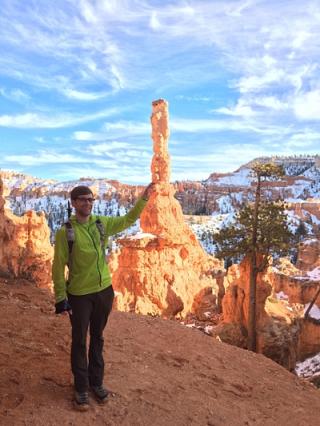
Ross Anderson, MD
PGY-2 Urology Resident (Resident 2014 - 2019)
Portland, the city where young people go to retire.
The beer is world-class, coffee shop baristas compete for who can make the best Mona Lisa in the foam of your coffee, and there are more restaurants that open each week than nights of the week. You are twenty-something, you just finished medical school, why would you want to leave? More specifically why would you want to move to Salt Lake City? This is the question I asked myself and more frequently other people asked when I told them where I matched in urology.
I grew up in Portland, I went to the University of Oregon, and then I did medical school at OHSU. Oregon is a wonderful place that now holds an almost mythical status in my mind, but it is no longer my home and I could not be happier about it.
My co-resident and I often refer to this program as a diamond in the rough—urology applicants across the country just don't know about it or don’t seriously consider it. I feel lucky that I knew a senior urology resident at Utah that graduated from OHSU. Then I met a practicing urologist in Oregon and he only had good things to say about the program. They put the University of Utah on my radar.
The other residents on this website do a good job describing how we have specialists in every sub-specialty and we have more operative cases than we have residents, so I won’t repeat much of that here. How a medical student chooses where to apply and ultimately how to rank those programs is an incredibly complex and individualized process. I would argue that most people are somewhere on a continuum between those that use a 73-point Excel-based algorithm and others simply choose a location or home institution.
I want to briefly share how I ultimately chose Utah. First, it needed to be a rigorous training program that would prepare me for either obtaining a fellowship and an academic career or provide the clinical/operative skills to be ready for private practice on day one. Second, I wanted a faculty and program that would both support me as a resident and a person. Third, I knew myself well enough to know how I recharge after long days/weeks at the hospital – simply being outside. The access to trail running/biking/hiking is literally out the hospital parking lot. World class skiing and snowboarding is 30 minutes away. For example, in my intern year I was lucky enough to visit every national park in Utah my intern year (don’t tell the general surgery program).
University of Utah is a diamond in the rough, it’s the complete training program that also provides a beautiful place to live and have fun during the time you’re not in the hospital. To my surprise, you can also find a great cup of coffee in Salt Lake City.
As a PGY-2, you can expect:
| Day | Tasks |
| Monday |
AM: Resident Conference, Imaging conference, VA post-op clinic PM: R2 follow-up clinic |
| Tuesday |
AM: RALP (bedside), TURP PM: TURBT x2 |
| Wednesday |
AM: Indications conference, VA post-op clinic PM: R2 follow-up clinic |
| Thursday |
AM: Ureteroscopy, hydrocelectomy, circumcision PM: Robotic partial nephrectomy |
| Friday |
AM: Prostate biopsy clinic (6-10/day) PM: Prostate Biopsy, Patient calls |
